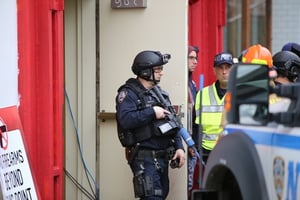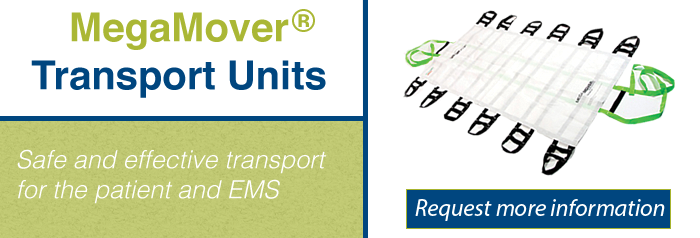
EMS personnel face crisis and trauma situations daily.
However, few things are more stressful and risky than a situation involving an active shooter. If these situations seem to be increasing in frequency and severity, it is because they are. As these situations become more frequent, first responders must stay safe, yet act decisively, in order to provide critical care and remove victims from the area. Therefore, there are specific things you need to know to prioritize EMS health and safety.
The Rise in Mass Shootings
Training for first responders has greatly evolved since a lone gunman appeared in a Texas clock tower in 1966. According to a study conducted by the FBI, there were 220 active shooter incidents between 2000 and 2016 in the United States. Not counting the shooters, these 220 incidents resulted in the deaths of 661 people and wounded another 825. Last year (2017), there were 28 active shooter attacks—injuring 700 people and resulting in 147 deaths. Regardless of where, when, or why these attacks occur, it is the response of law enforcement, EMS personnel, fire, and other support services that aid in mitigation and recovery during a mass shooting or other mass casualty incident.
Understanding an Active Shooter
The agreed-upon definition of an active shooter as defined by government agencies—including the White House, US Department of Justice, FBI, US Department of Education, FEMA, and Homeland Security is as follows:
…”an individual actively engaged in killing or attempting to kill people in a confined and populated area.”
Background and Data
According to a study by the FBI of 160 active shooter incidents, the following information was gathered:
- The shooter stopped the majority (56.3%) of the incidents—either when he or she committed suicide, stopped shooting, or fled the scene.
- Most incidents involved a single shooter.
- In at least 9 of the 160 incidents investigated, the shooter shot and killed a family member in a residence first and then moved to a more public location to continue shooting.
- Only 5% of shooters were female.
- Forty percent of shooters committed suicide and the suicide took place at the scene of the crime in 84% of these cases.
- The majority (70%) of incidents occurred in commerce or educational environments.
- The damage occurs in minutes—in 63 incidents where the duration could be ascertained, ~70% ended in less than 5 minutes and approximately 37% of those ended in fewer than 2 minutes.
EMS Actions During Active Shooter Incidents
EMS personnel health and safety is of the utmost importance, yet this need is also balanced with the necessity of providing critical wound care to the victims as quickly as possible. EMS personnel are typically required to remain in a safe area until the entire area is secured and the threat of additional harm is mitigated. Many emergency providers may find it difficult to wait to provide care to people in need. So how do we balance the risks for both patient and provider? For this reason, situational training is vital.
In addressing this concern, the Ohio State Board of Emergency Medical, Fire, and Transportation Services developed The Evolution of EMS Response to Active Shooter Incidents report. This report notes that some "EMS agencies have developed programs to enter “warm zones” of active shooter incidents (ASIs). These programs enable EMS to provide care for wounded victims while under the protection of armed law enforcement officers."
They went further to identify a three level guideline for EMS practitioners to provide care:
- Accept no significant risk when no lives or property can reasonably be saved at an emergency incident.
- Accept some limited level of risk, within normal operational procedures, when it is likely that lives or property can reasonably be saved.
- Accept a significant amount of risk, again within operational guidelines, when it is likely that a life can be saved.
Duties of EMS Personnel in the Zones
On May 1, 2018, the National Fire Protection Association (NFPA) released NFPA 3000 (PS) Standard for an Active Shooter/Hostile Event Response (ASHER) Program. The ASHER document clearly outlines the duties and responsibilities of fire and EMS personnel in the “critical hot, warm, and cold zones” of a mass casualty incident. The emphasis in the Hot Zone is suppressing the threat, preventing further casualties, moving the injured to safety, and controlling any life threating hemorrhage. EMS Personnel are usually found in the Warm Zone. It is here that a potential threat still exists, but it is not immediate. Care in this zone includes life-saving interventions such as applying the MARCH algorithm (Massive hemorrhage, Airway, Respiration, Circulation, and Hypothermia). In the Cold Zone, additional medical and transport resources may be staged and evacuation can be mitigated.
One important feature of ASHER program is the movement of patients from Hot to Warm zones when a threat is still present. The movement of an injured person during a mass shooting, especially in the Hot Zone, requires quick transport and the ability to keep the patient low to the ground. In the Warm Zone, the threat is less, but being able to quickly deploy a stretcher or to move victims quickly and on uneven terrain can be essential. For this reason, the MegaMover™ Transport Unit should be in the kit of any first responder.
The MegaMover™ is a safe way to transport patients in emergency situations. It is flexible, compact, and portable and can go to areas where stretchers are inaccessible. Furthermore, the MegaMover™ has 14 handles to allow for ergonomic lifting and can be discreetly moved (dragged) over grass, down stairs, and allows EMS personnel to keep the patient low to the ground to protect them from gunfire, if necessary. This is something a typical stretcher or gurney cannot do.
ASI Preparation
The previously referenced UConn EMS Program presentation presented a T.H.R.E.A.T. acronym as a sequential pattern of behavior during an ASI:
- Threat suppression
- Hemorrhage control
- Rapid Extrication to safety
- Assessment by medical providers
- Transport to definitive care
The EMFTS Board report also discussed the creation of an Active Shooter Rescue Task Force (RTF) stating, "The Active Shooter Rescue Task Force (RTF) program takes the best of numerous other protocols, including patient care, and collaborates with area law enforcement agencies to provide rapid treatment for casualties in an active shooter scenario."
The need for ASI training and preparation is nation-wide and the EMS World Expo, beginning October 29th in Nashville, TN, will be presenting an Active Shooter Workshopto address this critical issue. Furthermore, to prepare you to mitigate a mass casualty event.in a tactical fashion, there will be an “Active Shooter Mass Casualty Incident Demo” presented by Southeast Tactical LLC and local law enforcement.
Graham Medical, manufacturers of the MegaMover® Transport Units, will be attending the expo. We will be happy to discuss this and other topics with you. Contact us here to request a free sample of the Megamover™.

